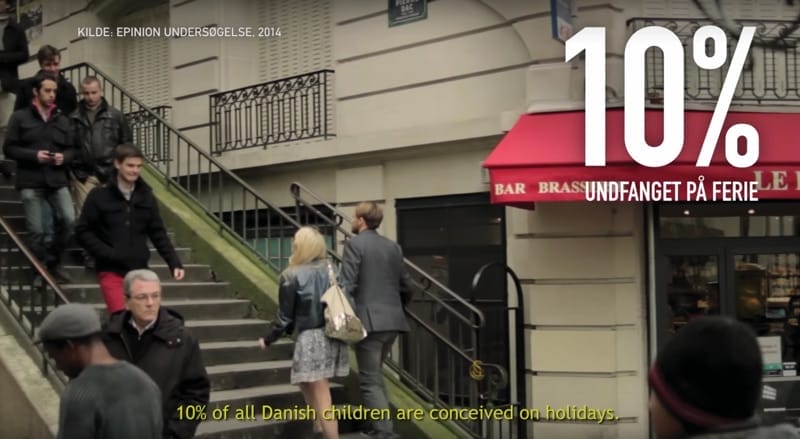Why the world’s population is lurching towards decline – and what we can do about it
Startling childbirth figures from China, published on 3rd January 2019, leant support to an emerging demographic theory that the world’s human population will soon start shrinking, fast. But why has our species taken the collective decision to cull itself? And is there anything we can do to prevent a population crash? In DG #34 we spoke to the experts to find out

Photo: Victor Fraile / Corbis via Getty Images
3rd January 2019 (Taken from: #34)
On Thursday 3rd January, four glum-looking representatives of the Chinese Academy of Social Sciences trooped into an anonymous, strip-lit conference room in Beijing to present the 19th annual Population and Labour Issues Report. Despite the minimal fanfare of its launch, it is a surprisingly explosive document.
“For the Chinese population,” it states, “the biggest population event in the first half of the 21st century is the arrival of the era of negative population growth.” According to the report, if the Chinese continue to reproduce at the same low rate as now, their numbers will plateau in 2027 – three years earlier than previously predicted – and then enter permanent decline. By 2065, China’s population will have fallen by 270 million from its peak and there will be far more old people than young.
“Long-term population decline, especially when it is accompanied by a continuously ageing population, is bound to cause very unfavourable social and economic consequences,” concludes the report, despondently.
That the most populous nation in history is on course to jettison 18 percent of its citizens in less than 40 years is striking – but these official numbers may even be underestimating the scale of the drop. The ‘replacement’ fertility rate at which a society’s numbers remain stable is an average of 2.1 births per woman. China’s official rate has fallen from 2.75 in 1979 to 1.6 today.
China will have fewer young people to support older people or to drive consumption by renting apartments or buying cars”
“That is half a baby short of what you need to sustain a population,” says John Ibbitson, co-author of Empty Planet: The Shock of Global Population Decline. “But there are a lot of people who suspect that China’s fertility rate may be closer to one, because it is close to one in Japan, South Korea, Taiwan and Singapore. If China’s number converges with those of the countries around it, it could lose far more than 300 million people in the course of this century.”
Ibbitson, a veteran Canadian journalist, believes that population decline in China will be “one of the dominant narratives of the 21st century”. “Declining populations are good for some things, but they’re really bad for economies,” he says. “Starting in about a decade, China will have fewer young people to pay taxes to support older people or to drive consumption by renting apartments or buying cars – all the things that power an economy. If the country does go into a period of prolonged economic stagnation, that could lead to increased unrest. And as we know, there is nothing in the world more dangerous than an empire in decline.”

China’s ‘one child’ policy helped suppress its birth rate, but other countries’ rates are also falling
But a precipitous drop in birth rates is not unique to China, whose infamous ‘one child’ policy, imposed in 1979, was only retired in 2016. The ‘Global Burden of Disease’ study published in medical journal The Lancet in November 2018 showed that fertility rates in 91 of the world’s 195 countries now sit below replacement level (it also has China’s rate at 1.5). The populations of around two dozen countries are already shrinking. Japan lost almost 450,000 people in 2018 as deaths outstripped births, and the nations of eastern Europe have lost six percent of their collective population since the 1990s, a total of 18 million people.
Despite these falls, the United Nations Population Division’s medium variant prediction has the global population continuing to grow to 10.9 billion by 2100, before levelling off. Ibbitson is sceptical of the projections. “It has been at the back of my mind for some time that these UN numbers seemed wonky,” he says. “They seemed wonky in 2001 when I wrote my first story about population decline and they seem wonky now.”
After discovering a body of academic writing questioning the UN narrative on birth figures, he teamed up with Darrell Bricker, CEO of research company Ipsos Public Affairs, and the two travelled the world to try to find the truth about our planet’s future occupancy rates.
Their investigation, laid out in meticulous detail in Empty Planet, led them to conclude that, far from hitting 10.9 billion, the world’s population will peak at nine billion at some point between 2040 and 2060. It will then begin what they describe as “one of the great defining events in human history… a population bust – a relentless, generation-after-generation culling of the human herd.”
Empty Spain
In the eastern mountains of Oruense in north-western Spain you can buy an abandoned village with its own cinema, bar and four houses – one of which has 17 bedrooms – for €240,000 (£214,000). Five hours’ drive to the east in Burgos you can pick up a deserted village of 75 houses for €425,000 (£379,400). Meanwhile, just outside Cuenca, south of Madrid, you can purchase a vacant village with its own church, school, farm, selection of homes, vineyard and warehouse for €1.5 million (£1.38 million). All these offers and dozens more like them are available from Aldeas Abandonadas (Abandoned Villages), one of a host of estate agencies selling unoccupied villages across depopulated rural areas of the country.
The largest of these areas is referred to as España Vacía – Empty Spain. “We are talking about the most extensive continuous territory affected by depopulation in the Iberian peninsula,” says Dr Carme Melo, a lecturer in the geography department of the University of Valencia. “Empty Spain includes five different autonomous regions with around 1,200 towns and covers 63,000 square kilometres. Parts of it are referred to in the media as the ‘Spanish Lapland’ because they are so sparsely populated.”
Having a child is an act of personal fulfilment – but as it turns out, people are very quickly fulfilled”
Spain’s answer to Santa’s homeland has been created by the migration of millions of people over multiple generations from the countryside to the city. “People left because of a lack of decent housing, basic services and employment opportunities – particularly for women,” says Melo. “It started with the enclosure and privatisation of land in the 18th century, then industrialisation, the growth of the cities and the mechanisation of agriculture. And then there is the idea, reinforced throughout the centuries, that the city is synonymous with culture, opportunity and development, and that the countryside just holds us back. In the social imagination the idea that the countryside is less important than the city is very powerful. All these forces have led to the depopulation of this huge area.”
While Empty Spain is at the extreme end of depopulation, the phenomenon of urbanisation that created its bargainous deserted villages has been repeated across the world. Researchers at the North Carolina State University and the University of Georgia calculated that on 23rd May 2007, for the first time ever, there were more humans living in urban than rural environments. And when humans move to the cities one of the first things they do, after complaining about the size of the apartments and learning not to talk to people on public transport, is to stop having so many children.
“In a rural environment, children are economic assets,” says Ibbitson. “You can put them to work in the fields. In the city, they’re just an economic drain, another mouth to feed. In cities women have access to education, which leads to empowerment, which leads them to conclude that they don’t want to have as many children as their mother had.”
Birth rates that took a century-and-a-half to decline in the developed world are plummeting in a single generation in the developing world”
Religion – particularly of the go-forth-and-multiply variety – also factors in. “Organised religion is more powerful in rural environments than it is in urban environments,” says Ibbitson. “Then there’s the declining power of the clan. In the village, you’re surrounded by your extended family, all those aunties urging you to get married and have children. In the urban environment, you’re surrounded by office workers. When was the last time one of your co-workers urged you to have a baby?”
“These things combine, with the result that if you and your partner decide to have a child, you’re not having it for economic advantage or because God or your family tell you you must. You’re having it because you and your partner want to. It is an act of personal fulfilment – but as it turns out, people are very quickly fulfilled. One or two kids is usually enough.”
Spain’s own fertility rate currently stands at 1.4. Its population began shrinking in 2011, and its institute of national statistics predicts that on current trends it will lose half a million people in the next 15 years and 5.4 million by 2066.
Hungarian women who have four or more children will be exempt from income tax for the rest of their lives”
Ibbitson and Bricker believe the UN is underestimating the effects of urbanisation on birth rates. “Urbanisation is accelerating and as a result of that acceleration birth rates that took a century-and-a-half to decline in the developed world are plummeting in a single generation in the developing world,” says Ibbitson. “The UN has India at 2.3, but demographers we talked to in the country suspect that it’s actually closer to 2.1, that the data’s out of date. The new Lancet study has India at 2.1 – replacement rate. I think that’s the sort of thing we should stand up and wave our arms around about. The world’s second-largest country is not going to be a generator of a whole lot of babies going forward.”
Baby drivers
In 2013, Eva Lundgren saw an article in a Danish newspaper that caught her attention. “It wasn’t front-page stuff,” she says. “It was more like page ten, a story about Denmark’s birth rate and how it could make problems in our welfare system, which we Danes are very proud of. It said that with the birth rate declining we wouldn’t be able to have the support for the elderly in the future that we have today.”
Lundren works as head of marketing for Spies, a Danish travel company owned by Thomas Cook Northern Europe, and decided she could help boost Denmark’s 1.7 birth rate at the same time as getting her brand some useful exposure. And so ‘Do it for Denmark’ was born. The campaign consisted of a series of adverts setting out Denmark’s demographic problem and suggesting that Danes might like to fix it by going on holiday and having sex with their partner. It increased Spies’ sales by 40 percent.


In addition, women could go onto the Spies site, put in the date of their period, and automatically be sent special promotional deals for city getaways on days when they would be ovulating. Should their mini-break result in a pregnancy, they could send a doctor’s report of the due date to Spies to be entered into a competition to win three years’ worth of baby supplies and a kid-friendly holiday. “We thought nobody would enter,” says Lundgren, “I mean, the requirements were pretty high. You had to be pregnant to take part. But seven people did.”
‘Do it for Denmark’ also helped to get the issue of falling birth rates onto the national agenda. “I think we pushed the ball, and it started rolling, and then somebody else pushed it as well, and we all got a higher awareness to the problem and how serious it was if we didn’t do something about it,” says Lundgren. The city of Copenhagen produced a pro-conception campaign and a documentary entitled Knald for Danmark (“Screw for Denmark”) was broadcast on national TV.


Then in 2015, after dropping constantly over many years, the birth rate registered a little uptick. “That was very joyful for us,” says Lundgren. Her follow-up campaign, entitled ‘Do it for Mom’, focused on how sad Danish mothers of grown-up children would be if they did not become grandmothers. The proposed solution, unsurprisingly, was to encourage their offspring to go on holiday and have sex with their partner.
It’s not just Danish travel agencies that are trying to fix the imminent collapse of the human population, however. In February 2019 Viktor Orbán, the prime minister of Hungary (birth rate 1.4), announced that women who have four or more children will be exempt from income tax for the rest of their lives. In Italy (birth rate 1.3) the government is introducing a programme to give free farmland to women who have a third child. Meanwhile, Spain has created the official position of Commissioner of the Government against the Demographic Challenge (predictably dubbed a ‘sex tsar’ by British tabloids) to co-ordinate attempts to increase its birth rate.


Photos: YouTube
Ibbitson believes that none of these gambits – or more standard actions like increasing paternity leave or offering free childcare – are likely to have a significant effect. “They’re not successful because of something called the low-fertility trap,” he says. “Simply put, once your society has a low birthrate, it gets used to having one.” Ibbitson believes that immigration is the only way for countries with insufficient babymakers to keep their population topped up. “We realise that it is very difficult for some countries to simply accept large numbers of immigrants, but you must accept them if you want to continue to grow your economy,” he says.
This will not sit well with Orbán, who commented while he was introducing his eternal tax- break for fecund Hungarians that “Migration for us is surrender.” “Perpetual decline is also surrender, is it not?” says Ibbitson.
Immigration will not solve the broader problem of global population decline, and may even make it worse in the long term. When people emigrate from a place with a high fertility rate to one with a low fertility rate, they tend to adapt their baby expectations within a generation of their arrival. “If you leave the Philippines [birth rate 3.1] and come to Canada, you’re leaving one worldview and arriving in a completely different one,” says Ibbitson. “Even if you decide to retain some of the worldview of the place you left, your children certainly won’t. They will grow up in Canada and they will have modern Canadian values, and they will have the 1.6 children that Canadians have on average.”
Fewer, older, greener, kinder
A world with increasingly few young people would not be all bad. While there would be economic challenges, there would be fewer problems with youth unemployment, as young people became a precious resource (although they might have to pay almost all of their wages over in tax to support an ever-greater percentage of old-timers). Instead of trying to deter young immigrants from arriving in their countries, governments might start to actively court them in order to maintain productivity levels.
Should climate change not become irreversible before the global population tops out, then greenhouse gas emissions ought to start shrinking every year afterwards. The positive effect on the environment will be further enhanced by ever-increasing urbanisation which will allow marginal farmland to be rewilded. “In every way, shape and form, a declining human population is great for the planet itself and something to celebrate,” says Ibbitson, although he’s keen to emphasise that his research should not be used “as a manual for climate-change scepticism.” “We are talking about decades out,” he says.

Viktor Orbán, prime minister of Hungary, announces his new babymaking plan. Photo: Attila Kisbenedek / AFP / Getty Images
An ageing world may even bring with it what Ibbitson describes as a “geriatric peace”, with fewer testosterone-fuelled young men to join extremist groups, sign up for patriotic wars or headbutt one another in suburban pub car parks. But it may also be less innovative. “Young people tend to come up with all the good ideas,” says Ibbitson. “On the other hand, we’re still going to have large young populations in Africa and India for decades to come, so we may find that the innovation and creativity starts to centre around places like Lagos and Mumbai.”
If Ibbitson and Bricker’s theory is right, though, alongside economic and social upheaval, within most of our lifetimes we’ll also have to deal with a radical shift in our self-image as a species. “The coming change has never happened before in the history of humanity,” says Ibbitson. “There have been calamities, wars and famines that have reduced our numbers, but we’ve never deliberately decided, through individual decisions, collectively to do so. I wonder how it will feel to be a race that’s chosen to get older and get smaller – possibly forever.”
Slow Journalism in your inbox, plus infographics, offers and more: sign up for the free DG newsletter. Sign me up
Thanks for signing up.








